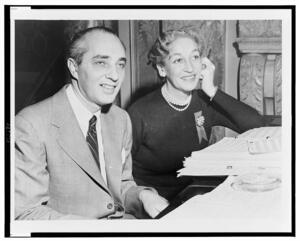Lyricist Dorothy Fields is inducted into the Songwriters' Hall of Fame
Songwriter and composer Dorothy Fields (1905–1974) and Arthur Schwartz work on score of "A Tree Grows in Brooklyn."
Photo by Walter Albertin, 1951. Source: Library of Congress Prints and Photographs Division. New York World-Telegram and the Sun Newspaper Photograph Collection.
The ten people inducted into the Songwriters' Hall of Fame in its first induction ceremony on March 8, 1971, included some of the most well-known names in American music: Duke Ellington, Ira Gershwin, and Alan Jay Lerner. The only woman in the group was Dorothy Fields, who over half a century wrote lyrics to more than 400 songs. Born in 1904 and raised in New Jersey, Fields was the daughter of Lew Fields, half of the well-known Weber and Fields vaudeville team. Though Lew Fields discouraged his daughter from pursuing a theater career, Dorothy Fields eventually became one of Broadway and Hollywood's most prolific lyricists.
Fields got her start writing songs for revues at New York City's Cotton Club. Collaborating with Jimmy McHugh, she wrote the lyrics for "I Can't Give You Anything But Love," "On the Sunny Side of the Street," "I'm in the Mood for Love," and "Don't Blame Me," all in 1928. Shortly thereafter, she was asked to write lyrics for a song Jerome Kern was adding to the score of the film Roberta. The song, which became "Lovely to Look At," was the beginning of a long collaboration between Fields and Kern. In 1936, they won an Academy Award for the song "The Way You Look Tonight," from the film Swing Time.
Fields also collaborated with such well-known composers as Irving Berlin and Cy Coleman, and with her brother, Herbert Fields. In all, Fields wrote lyrics for 19 Broadway musicals and 25 films. Among the musicals for which Fields wrote songs are Annie Get Your Gun, Sweet Charity, A Tree Grows in Brooklyn, Up in Central Park, and Seesaw. She died of a heart attack on March 28, 1974.
In a field in which the names of Jewish men from George and Ira Gershwin to Richard Rodgers and Stephen Sondheim are ubiquitous, Fields made her mark with some of the American musical theater's most memorable songs. A recent New York Times article quoted Sondheim's observation that Fields "wrote the way people talked... she did not distort syntax very often, the way Lorenz Hart and Ira Gershwin did." According to this article, many of today's prominent lyricists cite Fields as "one of the best practitioners of the art."
To learn more about Dorothy Fields, visit Jewish Women: A Comprehensive Historical Encyclopedia.
Sources:Jewish Women in America: An Historical Encyclopedia, pp. 433-435; New York Times, March 29, 1974, January 7, 2007.




The first induction ceremony was 1970, not '71. And the ceremony in '71 was held on march 1st, not 8th. Here's a link so you can check it out yourself: https://www.songhall.org/explore
Hope this helps.